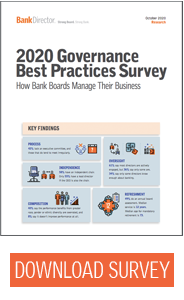
Governance Survey Results: Directors Sound Off on Diversity, Performance
Brought to you by Bryan Cave Leighton Paisner

 U.S. banks have made modest progress on improving the diversity of their boards of directors, but more work needs to be done, based on the results of Bank Director’s 2020 Governance Best Practices Survey.
U.S. banks have made modest progress on improving the diversity of their boards of directors, but more work needs to be done, based on the results of Bank Director’s 2020 Governance Best Practices Survey.
Sponsored by Bryan Cave Leighton Paisner, the survey was conducted in February and March of this year and included the perspectives of 159 independent directors, chairmen and CEOs of U.S. banks under $50 billion in assets.
Thirty-nine percent of the survey participants say their boards have several diverse directors, based on gender or ethnic and racial backgrounds. Thirty percent have one of two diverse directors but hope to recruit more. Thirteen percent indicate they have one or two diverse directors and believe that is sufficient, while another 13% say they have no such directors and would like to recruit some. And 5% say they have no diverse directors and aren’t seeking to add those attributes.
“What I say to boards is to look at your communities,” says James McAlpin Jr., a partner at Bryan Cave and leader of the firm’s banking practice group. “Many communities in the United States have undergone fundamental demographic change over the last 15 years.” Included in this demographic evolution is an increase in the number of women and minority business owners. “Then look around your board table,” he continues. “I think it’s really important for the board to reflect the bank’s demographic customer base.”
There is a solid body of academic research that diverse boards make better decisions, resulting in stronger financial performance. But not all of the survey’s respondents are on board with that assessment. While 52% agree that diversity improves a board’s performance, 40% believe it does to an extent but the impact is overrated, and 8% do not believe that diversity improves performance.
The survey also finds that a significant number of participants report a lack of engagement by some members of their board, with 39% saying that some or few of their directors are actively engaged during board and committee meetings.
Not unsurprising perhaps, the survey found that a significant number – 42% – report having at least one or two underperforming directors.
McAlpin suggests that engagement and performance issues “need to be addressed through board evaluation and feedback to those directors.” Unfortunately, less than half of the survey participants say their boards perform some type of periodic performance review, and just 31% include individual director assessments in that process.
Other Survey Results Include
- Fifty-eight percent of the respondents serve on board where the chair is an independent director. On boards where the CEO is also the chair, only 55% have a lead independent director.
- The median length of board service for the participants is 12 years; 76% are over the age of 60.
- Eighty-four percent identify as white and 78% as male. Just 1% are Black and 1% are Hispanic.
Click HERE to view the full survey results.
For a further analysis of the findings that examines process, independence, composition, oversight and refreshment, access “How Bank Boards Manage Their Business” HERE.



